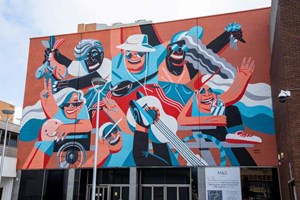
This three-year initiative starts in January 2024 and runs to December 2026. Around 5,000 murals across the UK will be recorded and photographed and make them freely available on the Art UK website. Painted murals will constitute a large part of this project, alongside sculptural murals in concrete, brick, wood, stone, tile and other materials.
Murals are located on the outside and inside of buildings and in public spaces, such as shopping centres, railway stations, churches and museums. The location of murals, the circumstances behind their creation, and the materials used to create them can result in this type of artwork being ephemeral in nature. Buildings and housing estates are demolished to make way for new developments meaning that many murals have been lost. The murals will be recorded as they look now, to provide a record if they are removed, defaced, or suffer environmental damage.
The murals project builds on the successes of Art UK's sculpture project, which ran from 2017 to 2021 and saw the digitisation of over 50,000 sculptures in public collections and in outdoor public spaces.
Art UK has not previously undertaken a digitisation programme which has included 2D painted murals. An accessible and immediate medium that has grown significantly in recent years, public painted murals have risen in profile as towns and cities embrace these vibrant artworks to inject colour and life back into urban areas struggling to find a new identity.
Contemporary street art has become extremely popular in recent years. The term 'street art' may typically make us think of art that is created without official permission but, despite the origins of some forms of street art in graffiti, much street art is now often sanctioned or commissioned. Although many forms of street art developed from graffiti, the main difference between the two is the intention and the audience.
Graffiti is primarily a word-based art that emerged in inner-city neighbourhoods as a way for urban youth to express themselves and their presence. Graffiti tags (words, names and symbols) are a form of branding and a way of marking territory. We will not be recording graffiti or 'tags' as part of this project.
Street art, on the other hand, is made to connect with a wide audience by putting across a message to them or simply providing something beautiful for everyone to enjoy.
Main Image :Marina Capdevila, Church Walk, Basildon, Essex Copyright Tracy Jenkins/Art UK

ArtDependence Magazine is an international magazine covering all spheres of contemporary art, as well as modern and classical art.
ArtDependence features the latest art news, highlighting interviews with today’s most influential artists, galleries, curators, collectors, fair directors and individuals at the axis of the arts.
The magazine also covers series of articles and reviews on critical art events, new publications and other foremost happenings in the art world.
If you would like to submit events or editorial content to ArtDependence Magazine, please feel free to reach the magazine via the contact page.